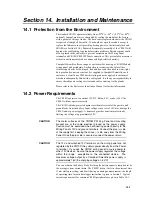
Section 13. CR10X Measurements
13-25
necessary, for each part of the calibration. Every 2.9 minutes
(8 seconds * 22) ten calibration coefficients are calculated. The calculated
coefficients are multiplied by 1/5, and then added to 4/5 times the existing coef-
ficients. Averaging is done as a safeguard against coefficients calculated from a
noisy measurement.
The above weighting of the newly calculated coefficients results in a 15-minute
time constant (see Instruction 58) in the response of the calibration to step changes
affecting the calibration coefficients (primarily temperature). For most
environmental applications a 15-minute time constant is acceptable. The auto-
matic calibration may result in the calibration coefficients not being optimum for
applications that subject the CR10X to extreme temperature gradients.
Automatic calibration extends the processing time by an amount which ranges
from 5.4 to 21.4ms when it is executed (every 8 seconds). If the processing time
of the program then exceeds the execution interval the CR10X finishes processing
the table and awaits the next occurrence of the execution interval before initiating
the table. At the fastest execution interval of 1/64 (0.0156) second the automatic
calibration always causes an overrun. If an overrun occurs every time calibration
is executed, then 1 execution is skipped for every 512 times that the program table
is executed. If the measurements are being averaged, the effect of the overrun is
negligible. Program table overruns are indicated by the appearance of two
decimals on either side of the sixth digit on the CR10KD and are also counted in
memory.
13.7.2 Instruction 24 Calibration
The alternative to automatic calibration is the use of Instruction 24, the calibration
instruction. Instruction 24 implements a complete calibration which occurs only
when executed by a program table. Instruction 24 calibration is the average of 10
calibrations, and takes approximately 2.8 seconds to complete. Automatic
calibration is disabled when a program is compiled that contains Instruction 24.
Instruction 24 calibration, as opposed to automatic calibrations, may be
advantageous in applications where: 1) the CR10X is exposed to extreme thermal
gradients, or 2) automatic calibration would interfere with the desired sampling
rate, and the ambient temperature is stable enough to allow calibration at specific
points during program execution.
The calibration coefficients are replaced each time Instruction 24 is executed.
Unlike automatic calibration, there is no time constant for the coefficients to
respond to changes in calibration. Instruction 24 calibration ensures that the
coefficients are optimum at the time that the instruction is executed. For example,
consider a CR10X mounted under the dashboard of a vehicle, where the
temperature could easily change by 50
o
. Temperature changes affect the meas-
urement circuitry which must be compensated for by calculating new coefficients.
Each time Instruction 24 is executed a new set of calibration coefficients is
calculated based on the measurements made at that time.
Calibration at a certain point during program execution may be advantageous for
some applications. For example, suppose Table 2 has an execution time of
15.6ms, but only executes when flag 1 is set. Table 1 has a 5-minute execution
time which makes a temperature measurement, and sets flag 1 if the temperature
exceeds a fixed value. To prevent overrun errors which would occur in Table 2 if
the automatic calibration was used, Instruction 24 could be executed before the
temperature measurement was made by Table 1.
















































